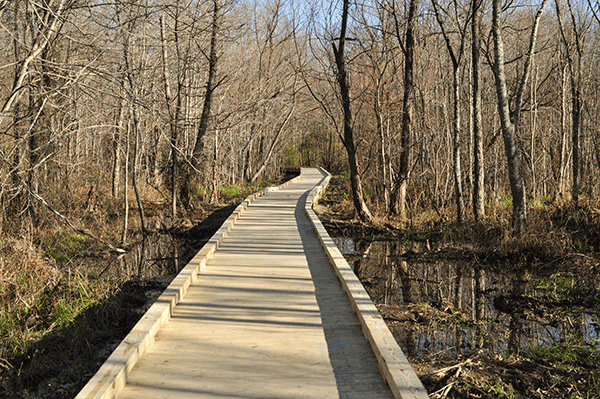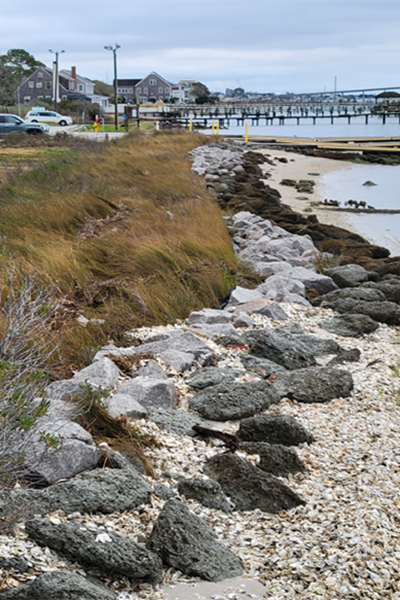
Hurricane Florence made landfall in North Carolina on Sept. 14, 2018, causing an estimated $22 billion in damages across the state. The storm left a lasting impact, disrupting power and water systems, displacing thousands of people and severely damaging critical infrastructure, including parts of the University of North Carolina at Chapel Hill.
In the days immediately following Florence, UNC-Chapel Hill Emergency Management and Planning (EMP) launched recovery efforts to address damages.
“Our office is responsible for developing and implementing strategies to make sure the University can continue operations during and after a crisis,” says Crystal Donaldson, EMP continuity and resiliency planner. “We help those areas across campus impacted by events like Florence navigate the funding process from start to finish.”
EMP partnered with the Town of Chapel Hill and Orange County for Federal Emergency Management Agency (FEMA) and North Carolina Emergency Management (NCEM) recovery reimbursement and mitigation funding. The funds, totaling close to $750,000, were used to support projects like the purchase and installation of a new generator for the Environment, Health and Safety (EHS) Building, rebuilding the Mason Farm Biological Reserve boardwalk, and repairing the Institute of Marine Sciences (IMS) shoreline and infrastructure.
Fortifying Emergency Operations
One of the more critical projects EMP initiated post-Hurricane Florence is the installation of a new generator to power the EHS Building off Estes Drive.
The EHS Building supports central coordination for managing and responding to emergency situations like Hurricane Florence. This coordination activity allows the University’s Campus Safety units to communicate vital information, manage resources like personnel and equipment, and handle recovery efforts to restore normal operations quickly.
Hurricane Florence revealed significant deficits with the facility’s current generator that only supports certain areas of the building during a power outage. Its limited capacity restricts the University’s emergency response capabilities, which led EMP to apply for a 300kW generator, estimated at $414,000, that would provide more areas of the building with power during an outage.
Before installation, the need for an even more robust power solution became evident as additional Campus Safety offices were set up in the EHS Building. EMP adjusted the request for a 400kW generator, estimated at $480,000, that would support most of the building’s operations, including larger meeting spaces that can serve as a call center or joint information center during major events.
“The generator is meant to proactively improve our infrastructure in anticipation of future disasters, rather than just being a replacement for an existing system,” says EMP Director Darrell Jeter. “The larger model improves our ability to support the University during any emergency event, not just hurricanes.”
Revitalizing the Institute for Marine Science

The IMS, located in Morehead City, was significantly impacted by Florence, and used FEMA funds to restore its shoreline and repair damaged infrastructure.
Classified as an off-campus research, education and service unit, the IMS campus spans over six acres of waterfront property. Its facilities include research vessels, laboratories, an indoor aquamarine center, and outdoor natural and manmade field sites.
The IMS emergency preparedness plans are unique due to their proximity to the coast. “We try to shut things down as carefully as possible, and keep up the things that are critical,” explains IMS Facilities Manager Stacy Davis. Early precautions involve moving research vessels to safer locations with assistance from the North Carolina Ferry Division and shutting down the facility’s mechanical system.
“It’s amazing to see how large the sea can get right here in front of the lab during a hurricane,” says Davis, who has worked at UNC-Chapel Hill for almost 30 years. “There isn’t anything that will stop Mother Nature when it gets to a certain point.”
Among the damage sustained was significant erosion to its shoreline. With waves reaching behind its border, the existing rock barrier was unable to withstand the high tides and winds.
FEMA funds supported repairs, including the installation of new heavy-duty matting to stabilize the rock barrier foundation. Old rocks were repositioned with an excavator, and new rocks were added atop the matting to reinforce it. Additionally, native grasses were planted behind the rocks to stabilize the soil, helping to prevent future erosion and support the local ecosystem. The total cost for the shoreline repair was just over $40,000.
The funds also supported improvements to the dormitory and shop facilities, including construction work on the dock that was completed in-house. “We’re always willing to tackle things by doing it ourselves,” explains Davis. “It saves quite a bit of money, and we’re able to get it fixed quickly.”
IMS Director Rick Luettich and Davis value the support EMP provides during major events like Hurricane Florence.
“EMP has established a relationship with us and will reach out, not just during or after a storm, but during the middle of the year, and ask if we need anything,” Luettich says. “Their support helps us stay focused on immediate operational needs and makes navigating recovery challenges much easier.”
| Project Title | Grant | Description |
|---|---|---|
| Boardwalk Roads | $38,897.97 | Repair series of gravel roads leading to different areas of the plan conservatory. |
| Botanical Gardens Walkway | $11,766.45 | Replace boardwalk that was damaged. |
| TEACCH Campus | $16,608.60 | Replace damage materials/furniture that were damaged by flooding. |
| IMS Coker | $46,908.69 | Repairs to Coker Hall and Coastal Processes Lab from water/storm damage. |
| TEACCH Protective Measures | $7,282.20 | Emergency protective measures to relocate to alternate facility. |
| IMS Shoreline | $41,114.46 | Replace roof on building, repair shoreline, and rebuild docks. |
| Brauer Hall | $5,190.13 | Repairs to drywall and building from water damage. |
| Campus Sandbagging | $4,065.60 | Emergency protective measures placing sandbags to prevent flood damage. |
| Debris Removal | $51,064.64 | Removal of debris across campus/university properties (fencing, vegetation, sand/soil, solid debris). |
| Finley Fields | $49,360.64 | Repair to outdoor facilities (turf, goalposts, sand, track, amplifiers, park equipment) |
| Campus North | $9,303.01 | Repair to outdoor facilities (hiking trails, foot bridges, and washed out land). |
| EHS Generator | $466,194.13 | Replacement and increase in generator supplying EHS building. |
| Totals | $747,756.52 |
